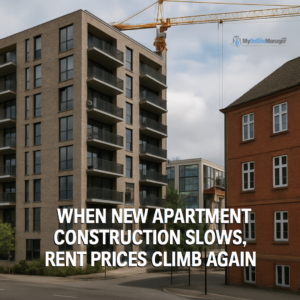The U.S. rental housing market is entering a new chapter and not necessarily a comfortable one for renters. After a period of relative stability, rent prices are beginning to climb again across major cities. A key factor driving this change is the significant slowdown in new apartment construction, which is tightening supply and gradually shifting market power back toward landlords.
During the pandemic years, a surge in new apartment developments gave renters more choices and helped cool rent inflation. But now, with developers pulling back amid rising costs and financing challenges, the balance is tilting once more and monthly rent checks are reflecting that shift.
In short: When fewer apartments are built, renters have fewer options, competition intensifies, and prices rise.
Construction Is Cooling Off Fast
New data reveals that apartment construction in the U.S. has slowed dramatically. In the months leading to March 2025, the average number of multifamily units permitted fell to just 12.4 per 10,000 residents a 27% decline from the boom levels seen during the pandemic.
This drop isn’t isolated:
-
63% of major metro areas are now permitting fewer housing units compared to their pandemic peaks.
-
Some cities that once led the construction boom are seeing sharp pullbacks.
-
Developers are facing higher costs, fewer incentives, and tighter credit markets, all of which make starting new projects far more difficult.
During the construction surge of 2021–2023, the steady addition of new units helped to stabilize rent growth. That wave of inventory is now tapering off and the effects are starting to ripple through the rental market.
Why This Slowdown Matters for Renters
Rent growth had cooled in 2023 and early 2024 thanks to the unprecedented delivery of new units. But as the pipeline dries up, demand once again exceeds supply in many cities.
Some key impacts:
-
Rising Rent Prices: National median rent in Q1 2025 rose to $1,754, about 1% higher year over year. This may seem modest, but it signals the beginning of a new upward trend.
-
Fewer Options: With less new housing coming online, renters face more competition for existing units, reducing bargaining power and increasing pressure to accept higher rents.
-
Tighter Market: When inventory is limited, landlords are less likely to offer incentives like free months or reduced deposits.
In a tight market, even small rent increases can hit households hard, especially in high-cost urban areas.
Regional Variations: Some Cities Feel It More Than Others
While the slowdown is a national trend, it isn’t hitting every market equally.
-
Sun Belt cities like Dallas, Phoenix, and Atlanta still have relatively high levels of permitting. Their boom isn’t completely over, so rent pressures there may remain moderate at least for now.
-
High-growth metros like Austin and Colorado Springs, however, have experienced some of the sharpest pullbacks. These areas are already seeing tightening supply and faster rent growth.
-
Coastal cities, which already faced chronic housing shortages, could be particularly vulnerable if permitting continues to lag.
For renters, this means the affordability picture may depend heavily on where they live. Markets with active construction pipelines may offer more options, while others could see rents rise more quickly.
Headwinds for Developers: Why Building Has Slowed
The slowdown in apartment construction isn’t just a matter of choice it’s a direct response to a tough economic environment. Developers face multiple headwinds:
-
High Interest Rates: Borrowing is more expensive, making financing new builds significantly less attractive.
-
Increased Construction Costs: Tariffs, supply chain disruptions, and labor shortages have all pushed costs higher.
-
Shrinking Margins: When costs rise but expected rents can’t keep up, many projects simply don’t pencil out.
-
Regulatory Hurdles: In many cities, complex permitting processes and local opposition delay or derail development plans.
The combination of these factors means fewer projects break ground, which in turn leads to less housing supply a classic supply-and-demand imbalance.
What to Watch: Signals of Where Rents Are Heading
The coming months will be critical for understanding how the rental market evolves. Here are four key trends to keep an eye on:
-
Interest Rates & Financing Costs
If borrowing costs ease, more developers may revive shelved projects increasing future supply. -
Permitting Activity
Cities that streamline permitting and reduce red tape could see construction rebound faster, stabilizing local rent growth. -
Vacancy Rates
When vacancies shrink, it’s often a precursor to steeper rent increases. Watch this closely in high-demand metros. -
New Construction Starts
Whether the slowdown proves temporary or long-term will shape the rental landscape for years to come.
Conclusion: A Turning Point for the Rental Market
The slowdown in apartment construction is more than just a blip on a chart it’s a warning sign for renters and policymakers alike. Without a steady pipeline of new housing, the U.S. risks sliding back into a cycle of rising rents and shrinking affordability.
For renters, this may mean preparing for less negotiating power and higher costs. For developers and governments, it’s a call to address financing, permitting, and cost challenges to keep housing supply aligned with growing demand.
The next 12 to 24 months will be pivotal in determining whether this is a temporary market adjustment or the start of another sustained period of rent escalation.

